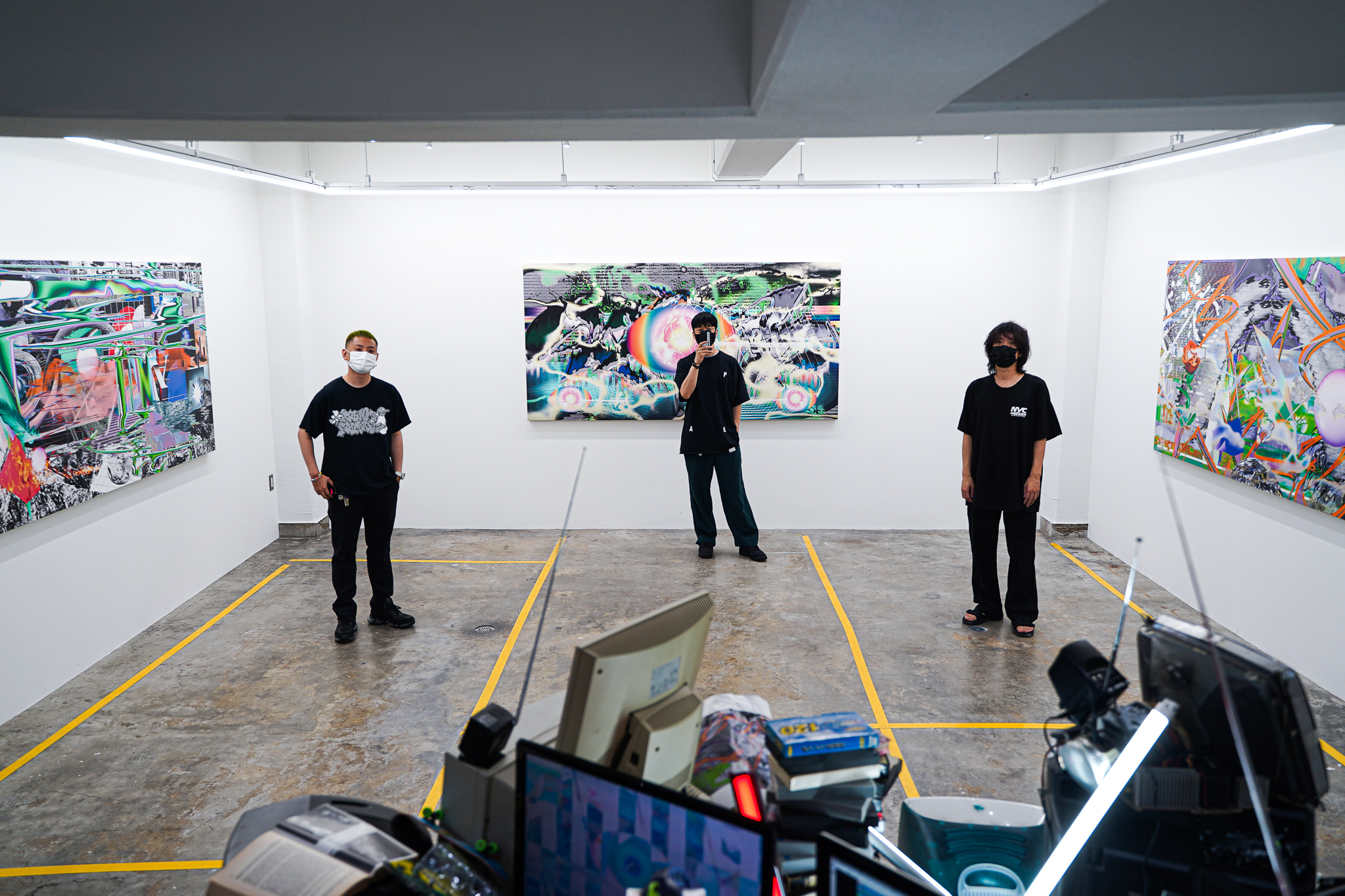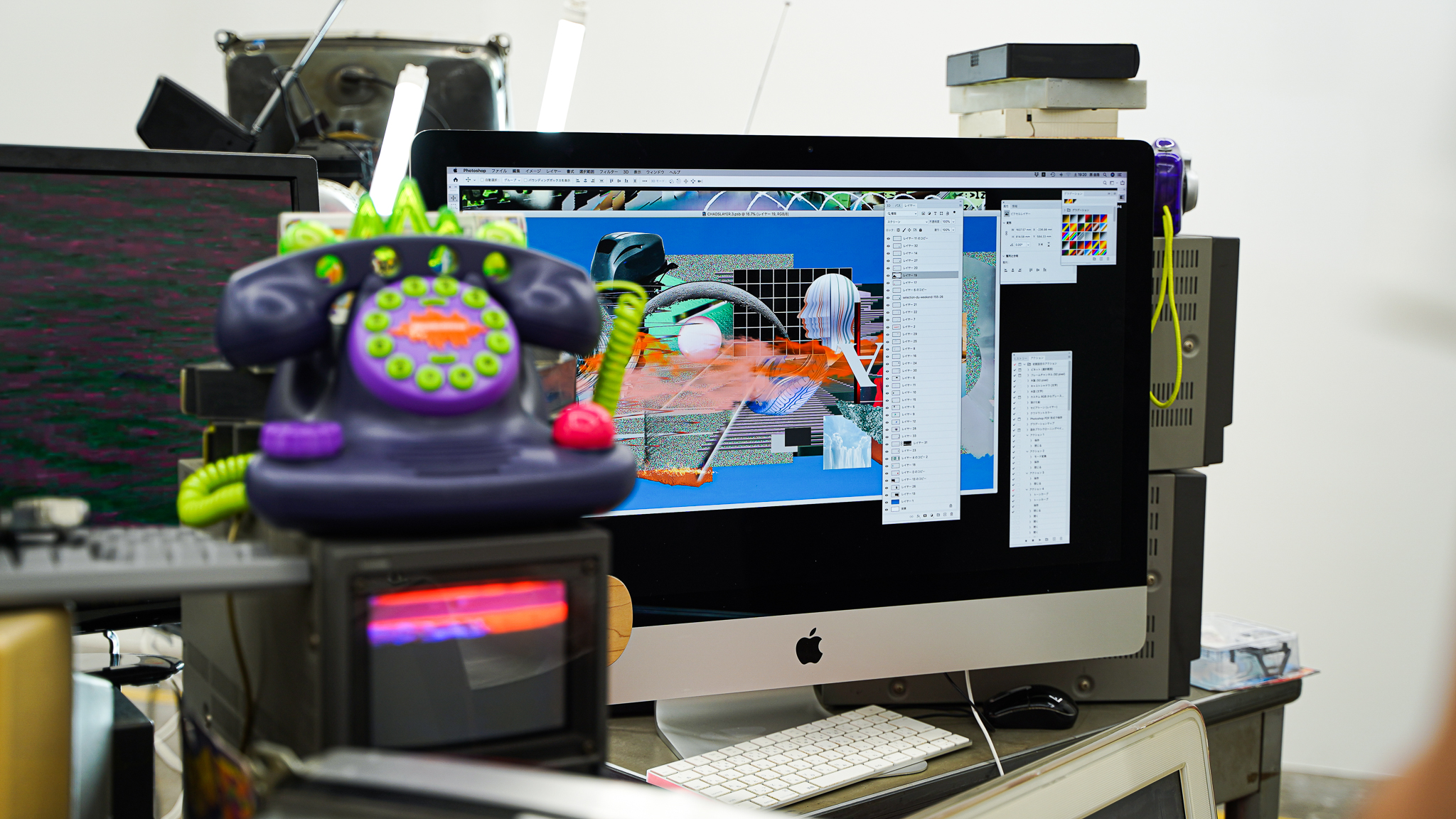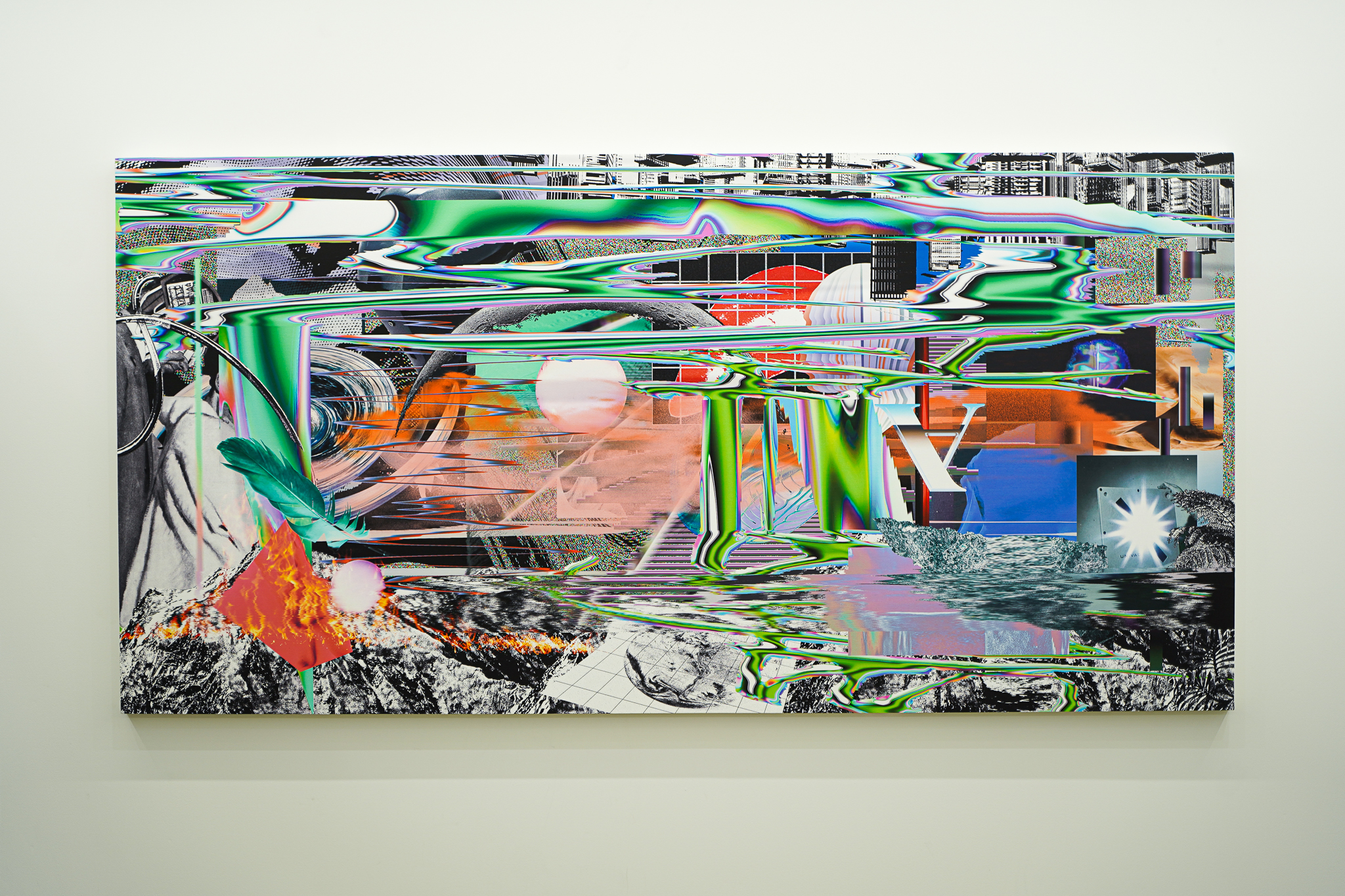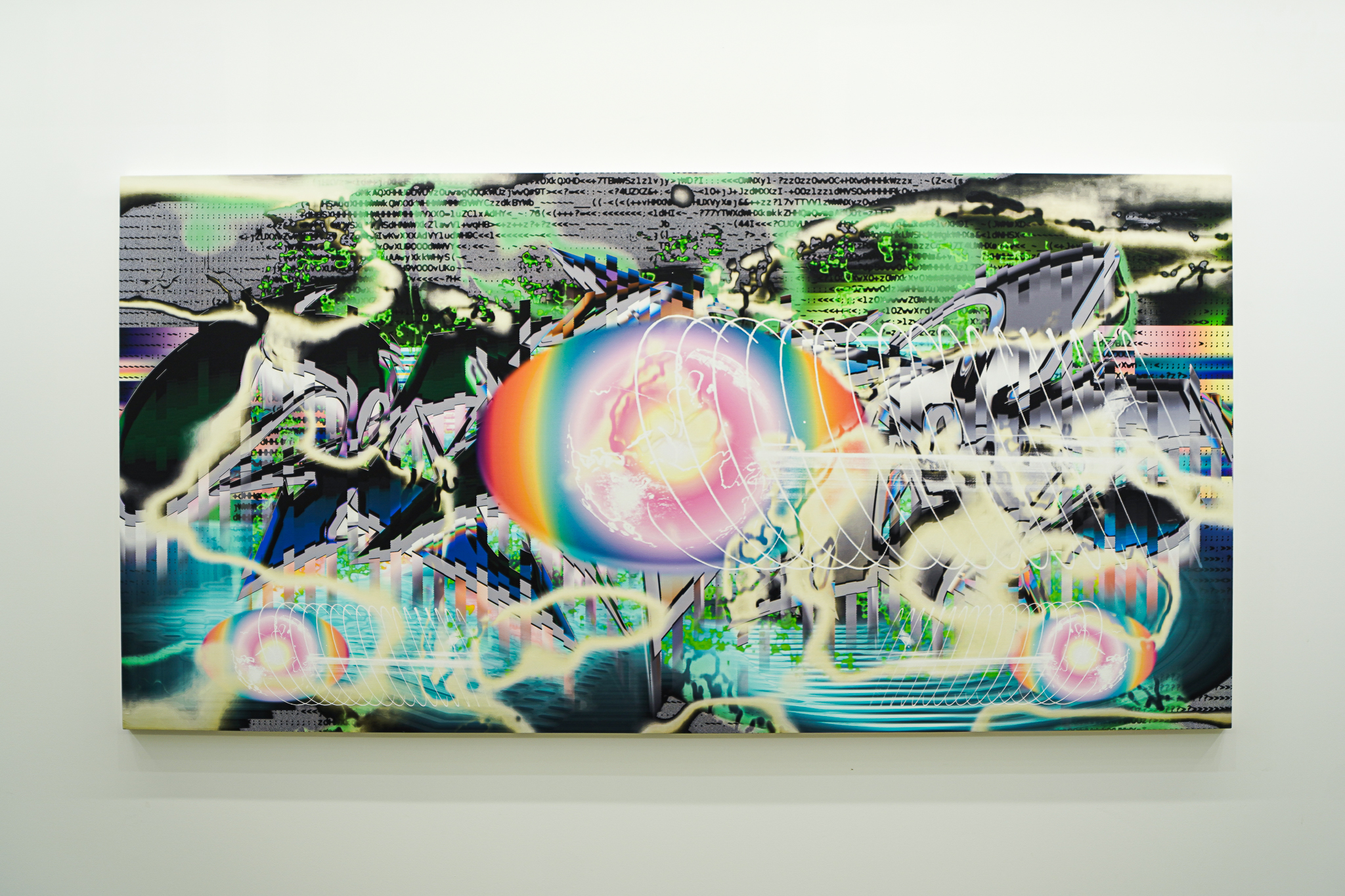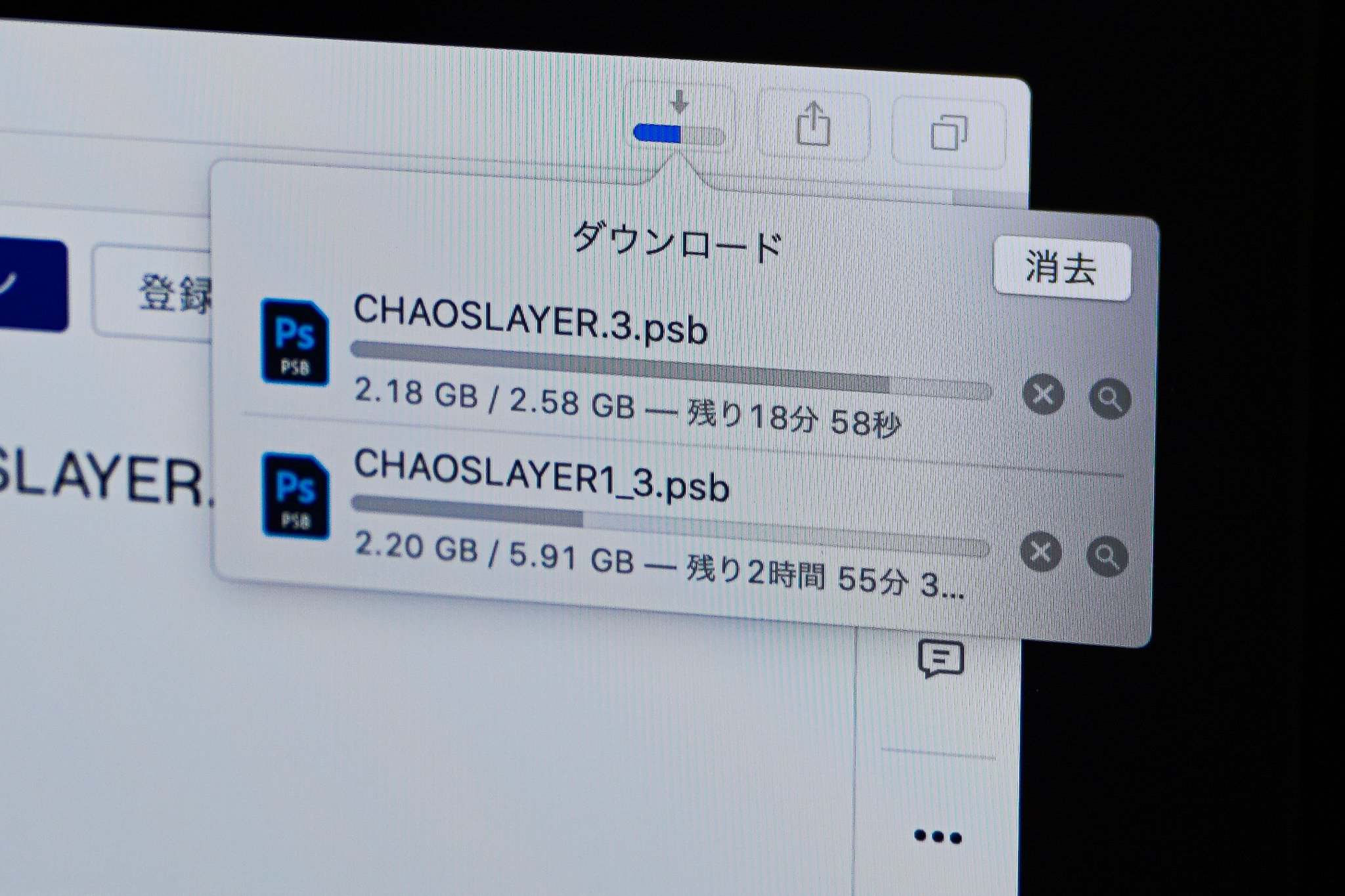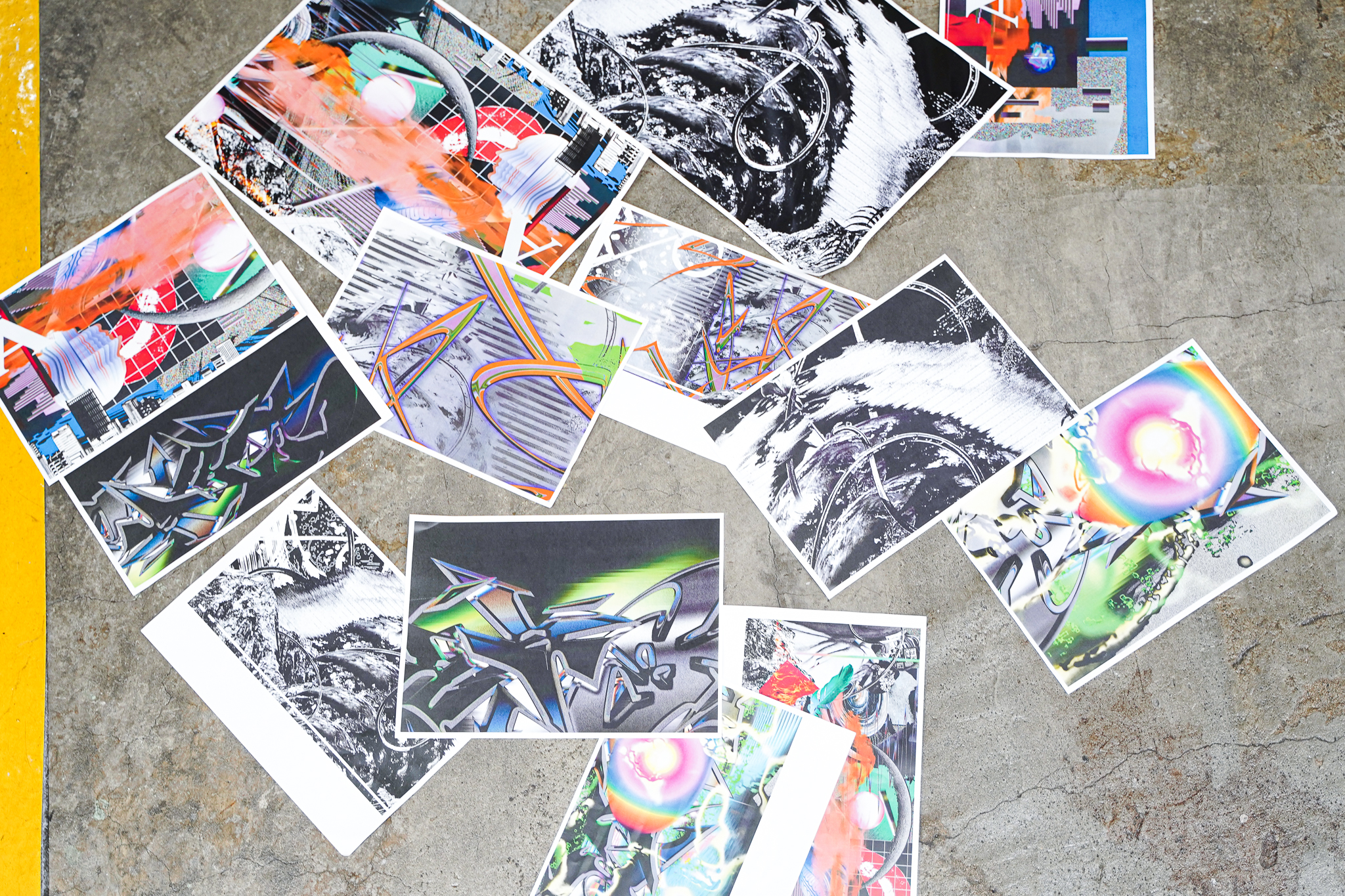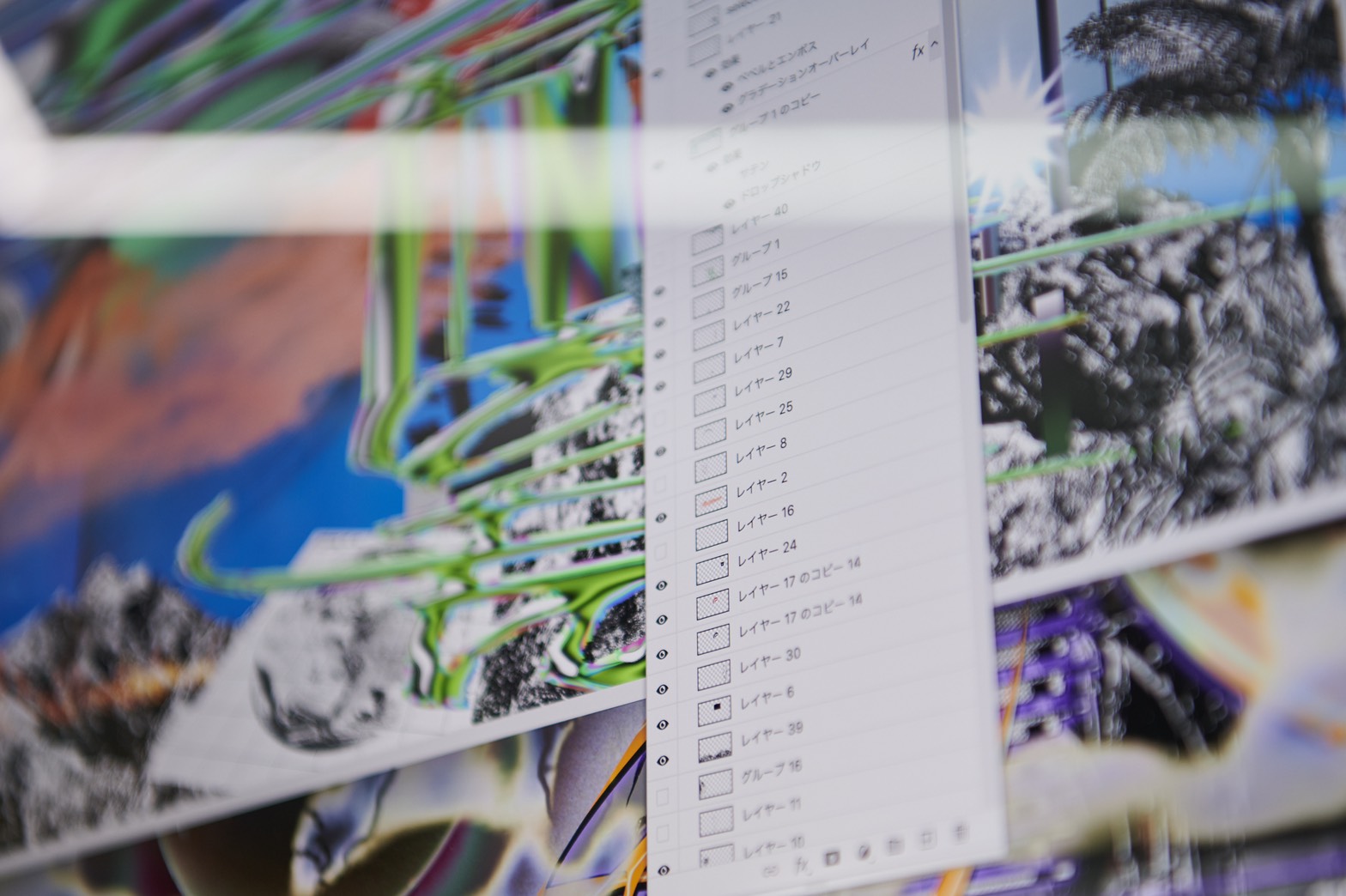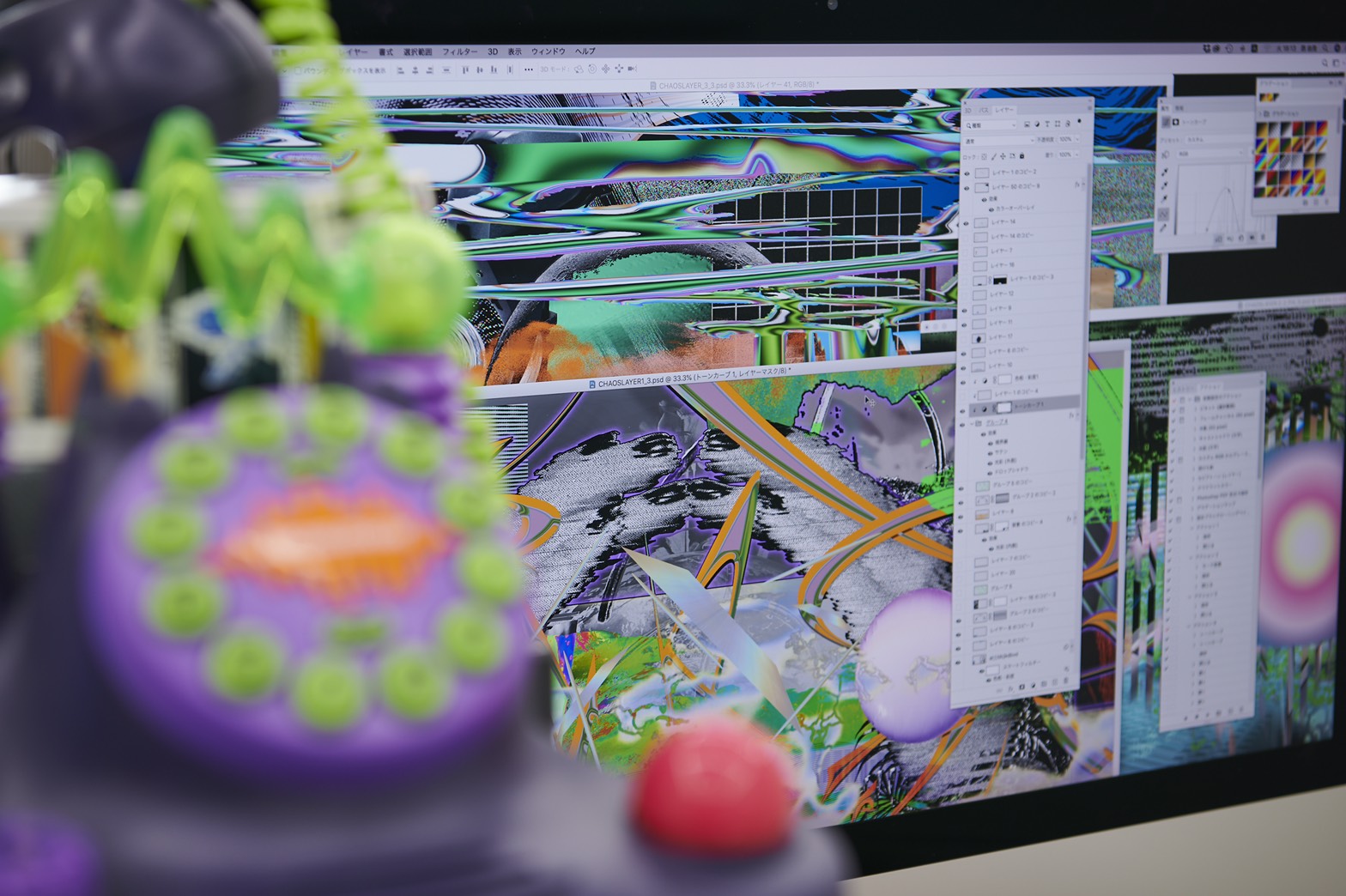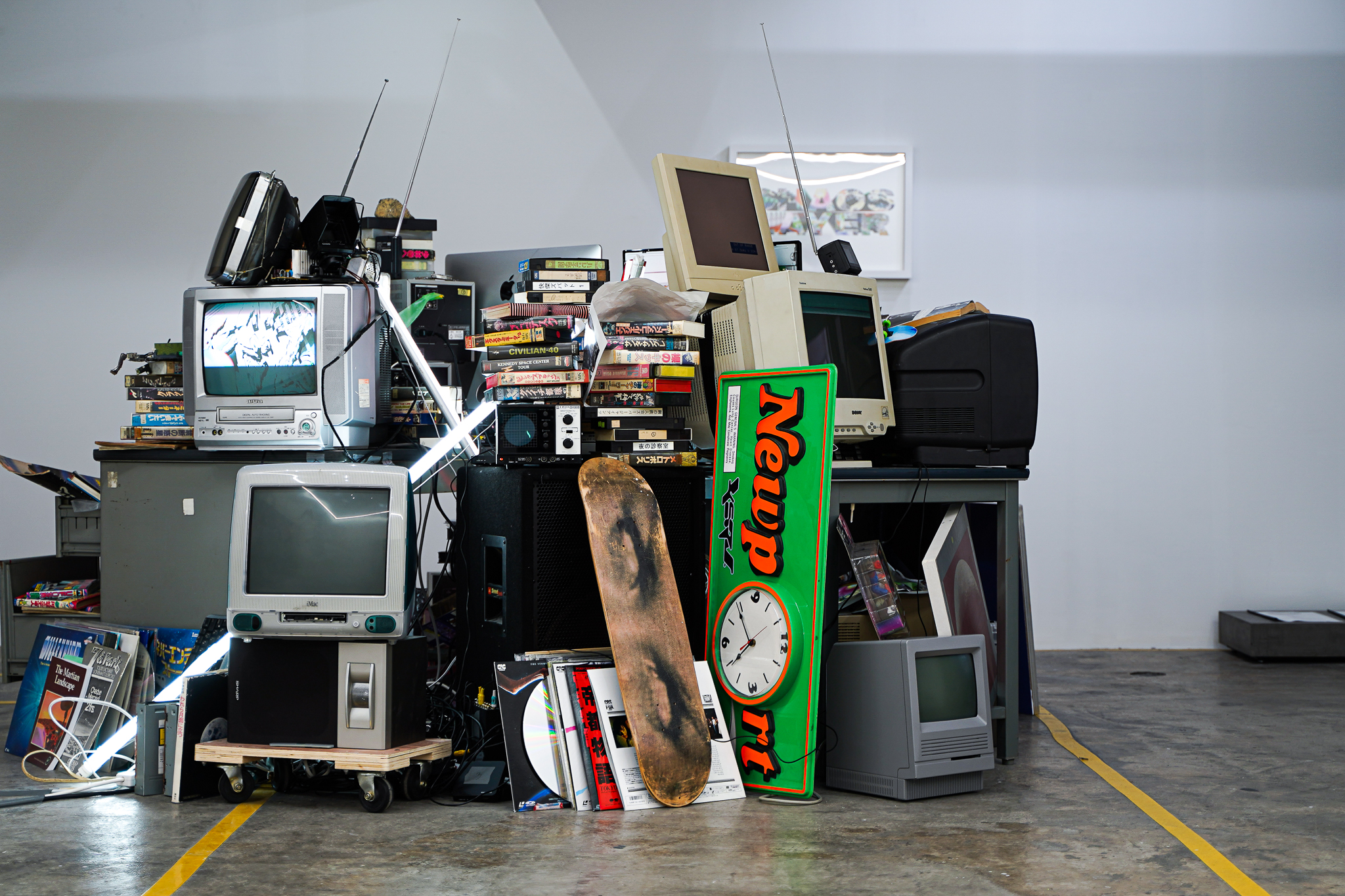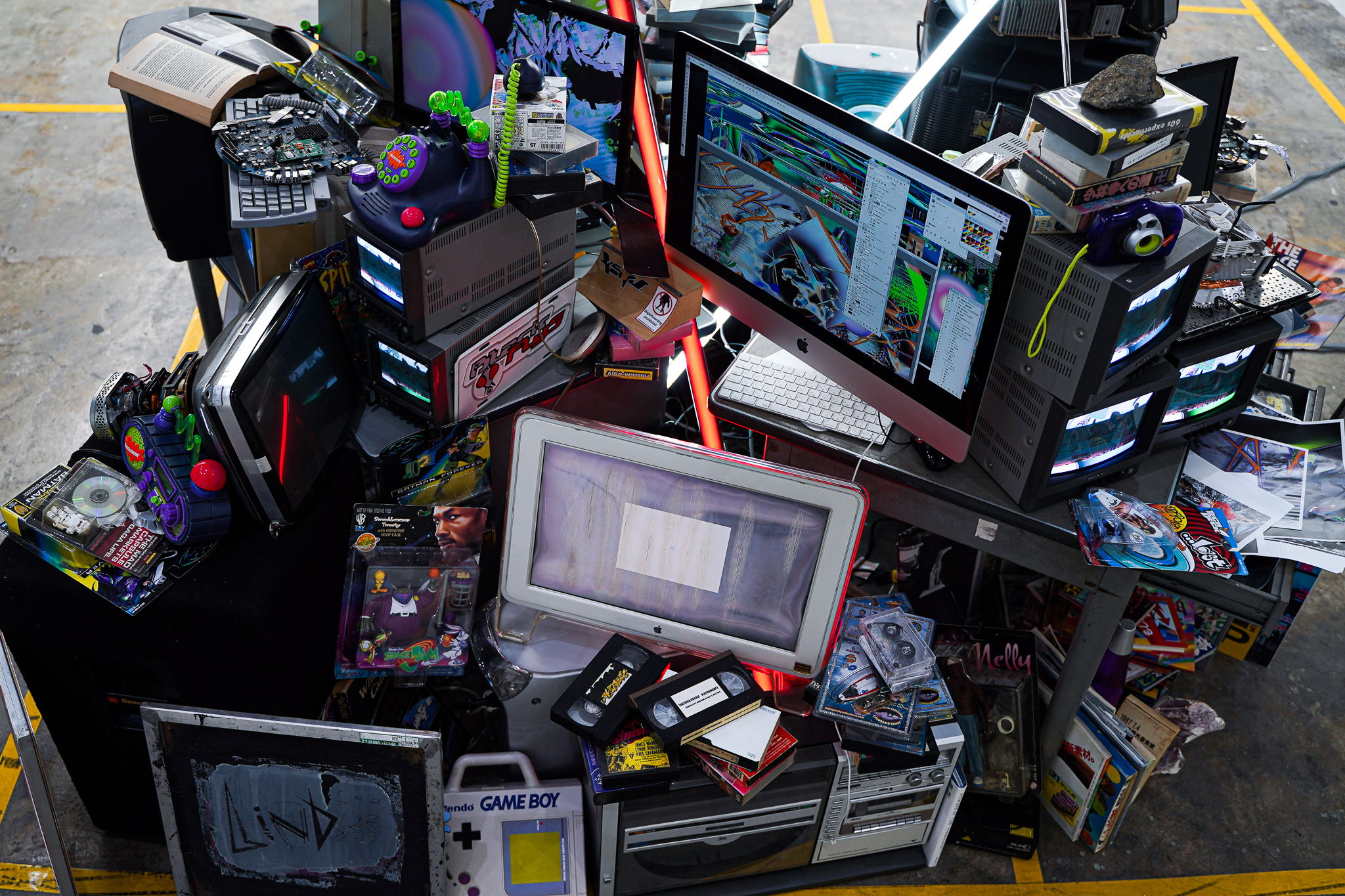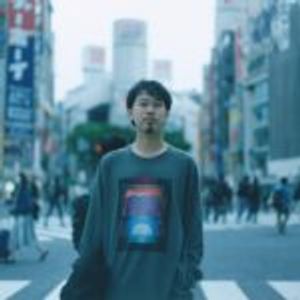Tacit agreement can be seen in multiple fields from business, science, music and fashion. It unequivocally exists in the art and design industries as well.
Gallery Tsukigime has moved in July and newly opened with the first joint exhibition with Tokyo’s illustrious graphic artists—KOSUKE KAWAMURA, GUCCIMAZE, and YOSHIROTTEN—titled CHAOS LAYER. The exhibition showcases three canvas artworks of digital collages rendered with a creative technique that takes a big step into the area of ‘tacit agreement,’ and 3D collage installation, CHAOS DESK, that invites us to envision the trio’s imaginary desk.
Their creative process was as follows: the first artist produces the base graphic, the second artist edits and coverts it, and the third artist brings it to completion by also editing and making final touches. Normally, artists or graphic designers would never consider sharing their unfinished work with others and letting a third person to tie up the loose end. Even if they did, it is hard to imagine the work looking good in the end. Yet, the qualities of the three art pieces in CHAOS LAYER are top notch. The question is, are these works deliberately splendid, or did they come from serendipity? And why did the three artists summon? We were able to speak to the trio and hear their narratives about the exhibited artworks they had rendered with a chaotic creative means and spawned in the cluttered world with the pandemic.
The trio who has marked the birth of a new style in the graphic art scene
ーーWhy did you decide to do this exhibition with the three of you?
YOSHIROTTEN: It started from the owner of Gallery Tsukigime, which moved and reopened at a new spot in July, asking me, “Can you give me an idea of a project that would be perfect for the new opening of this gallery?” I’ve been involved with the gallery since the very beginning when it first launched, so I wanted to celebrate its new opening with an impactful project.
ーーI see, so YOSHIROTTEN was the initiator of the project. And why did you ask KOSUKE KAWAMURA and GUICCIMAZE to join?
YOSHIROTTEN: I’ve always wanted to do something with the three of us for a long time. Recently, we’ve been increasingly seeing one another, and I thought that Gallery Tsukigime would be the right place for us to do and exhibit something special.
ーーTell us how you all met.
GUCCIMAZE: I first met YOSHIROTTEN. That was about ten years ago. I was still in Art University and occasionally played DJ at the same club as he did. That’s when I first talked to him.
YOSHIROTTEN: I met KOSUKE about five or six years ago. I don’t remember why but we happen to take a day trip to Kamakura together. After that, I remember introducing GUCCIMAZE to KOSUKE.
ーーWhat impression do you have of one another? First, from KOSUKE KAWAMURA, can you tell us about the two?
KOSUKE KAWAMURA (Hereinafter KAWAMURA): I’ve always checked them out since they first came out to the public. When I was around 20, there were many graphic designers rising in the world, and at that time, the entire scene was unified both in a good and a bad way. Since I grew up witnessing such scene, when YOSHIROTTEN came out, I remember being awed thinking, “His works are new and cool,” as he had a completely different style. Subsequently, GUCCIMAZE came out and I was also amazed by his works, which made me think, “What a new upgraded style.” When I first saw their works, I thought they were both foreign artists, so I was even more shocked when I found out that they were both Japanese. Since their styles were totally different from mine, I was thinking that I would never be able to become friends with them, but eventually, we hit it off really well [laughs].
ーーAnd GUCCIMAZE, what is your impression of the two?
GUCCIMAZE: When I met YOSHIROTTEN, he had a more punkish style. Before, I was able to tell like, “He’s probably collaging once to create his works,” but over the past ten years, his works have been evolving more and more that they always surprise me. I learn a lot from him such as the way he goes with the flow of time and the way he captures things that others don’t see. What’s amazing about KOSUKE’s works is that you can tell right away that they are his works. Putting out your “essence” sounds like an easy thing to do, but in fact, it’s insanely difficult. I admire both of their distinguishing styles and they both inspire me a lot.
ーーAnd how about you, YOSHIROTTEN?
YOSHIROTTEN: Like KOSUKE, I also grew up watching the older graphic designers and street artists in the noughties. And while I was thinking, “I want to do something different from what they are doing,” I found out about KOSUKE. In the unified scene, his collage style and works attracted my attention as they were different from others. In the beginning, I thought he was more towards the underground side as his artworks were often published in horror, occult indie magazines like TRASH-UP!! and he was providing his works to hardcore bands, but later I found out that he does major client works as well; so anyway, I knew about him as a person with an incredible style. When we finally met, we talked a lot and he made me feel that he would be my great buddy, who’s in the same generation and who I can talk to about the future.
ーーAnd what’s your impression of GUCCIMAZE?
YOSHIROTTEN: There weren’t that many people who did graphics and also went to clubs, so I was happy when I met GUCCI. There was a time we used to make PAN MAGAZINE together. Even since he became sought-after with his designs, he continues to hone his skills, making full use of his great ability of drawing by hand and integrating digital elements into his works. I’ve been watching his style flourish over time, so I’m honored to have had this opportunity to create these artworks together with him.
Sharing, converting and editing the data of work in progress. A chaotic creative process that involves the art of ‘tacit agreement’
ーーI heard that for this exhibition, CHAOS LAYER, you guys implemented a distinctive creative method.
YOSHIROTTEN: First, we didn’t want to do a simple group exhibition. We wanted to create something that us three, who are rooted in graphic design and street art, can only make. I was thinking, “Since we all produce art implementing digital techniques, we should create something that involves using data,” and later, we went out to get some food as well as to discuss about the project. That’s when KOSUKE told us, “I’ve layered about 25K layers with a photoshop data before,” which was for his artwork produced for the exhibition, Tower of Babel, with Katsuhiro Otomo. After hearing the story, we came up with an idea of completing an artwork together by relaying the ultimate layer data to one another.
ーーWhat do you mean by relaying the layer data to one another?
YOSHIROTTEN: Basically, we each prepare the same sized PSD data; the first person creates a graphic data, the second person edits and alters it, and the third person finishes it by also editing and adding final touches.
ーーNormally, artists would never exchange data of their incomplete work to others, right?
GUCCIMAZE: That’s right. Essentially, I think no one would ever want to exchange and share data of the artwork you’re still working on and let others touch and edit it. So, when I first heard about the idea, I was honestly shook. But at the same time, I was interested in trying this novel creative process, and I personally had the chills.
KAWAMURA: I was also a bit afraid when I heard the idea from YOSHIROTTEN. You never see other artists’ data.
YOSHIROTTEN: I’m sure everyone’s process of creating and data are respectively different.
KAWAMURA: I agree. It feels like showing yourself naked to people at a Sento (public bath) [laughs]. There are parts you hide and don’t want others to see, though, it’s like you’re forced to show them to others, which is embarrassing…. It’s also scary to see others’ data, but I can’t deny that part of me is curious to see what it’s like. Anyway, it was a creative method that I’ve never tried before, so I couldn’t imagine how they were going to turn out in the end.
ーーSince you’re saying, you couldn’t imagine how the works were going to look like in the end, does that mean you didn’t set up a theme, discuss the directions, or have a meeting to decide what kind of graphic you were each going to make?
YOSHIROTTEN: We only talked about making three same-sized large graphic artworks for the exhibition and exchanging data with one another using Dropbox, and that was it.
KAWAMURA: We were saying how bold and cool to only have three artworks for the exhibition. But in the end, it took as much effort as producing an insane number of artworks.
GUCCIMAZE: Other than what we discussed in the beginning, everything was done spontaneously. I checked each layer and balanced them out step-by-step.
YOSHIROTTEN: We weren’t working in the same space, but it felt like we were doing a session together. Regarding the one I finished (the artwork on the right side. The first was KOSUKE KAWAMURA, the second was GUCCIMAZE, and the third was YOSHIROTTEN finishing the piece,) by the time I received it from GUCCI, the hand part in the graphic was fading.
GUCCIMAZE: That’s because I made it in a silver-ish color.
KAWAMURA: Right. I remember it being silver-ish after it was passed to GUCCI.
YOSHIROTTEN: But I changed it back to its original state.
KAWAMURA: It was like an impromptu session. When I received the data from the two and it was my turn to edit, I was motivated to create something interesting, but when I saw the graphics, I could perceive each of their preferences and wanted to respect that. Let’s say, with YOSHIROTTEN’S work, I’d made sure to keep his staircase and not draw something similar to it. For the work I had finished (the center artwork. The first was GUCCIMAZE, the second was YOSHIROTTEN, and the third was KOSUKE KAWAMURA,) it was straight-up GUCCI style per se that I had a hard time figuring out what to do with it, but in the very end, I checked with GUCCI and asked, “is it okay if I shred it?”
YOSHIROTTEN: I also had to check with GUCCI on one part, like, “it’s going to change a bit if I put this together, but are you cool with that?” Other than that, I didn’t ask him anything.
GUCCIMAZE: Everyone was doing their thing. By the way, I didn’t ask the two anything when finishing the piece [laughs].
KAWAMURA: As it was something I’ve never ever done before, I had trouble with some parts. I’ve changed the order of layers, embedded sources, but I couldn’t just go ahead and delete the layers without their permissions.
YOSHIROTTEN: In the end, each data was over 5GB.
KAWAMURA: I know. It was too heavy to upload the data and I couldn’t upload to Dropbox at all.
YOSHIROTTEN: I was the one who said we should use Dropbox to share data, but KOSUKE was having trouble uploading.
GUCCIMAZE: So, we received his data via Gigafile and uploaded it on Dropbox for him [laughs].
ーーWhat impression did you have on one other’s layer data?
YOSHIROTTEN: GUCCI’s data was incredibly beautiful. I also found out that he leaves all the adjustment layers.
GUCCIMAZE: That’s right. I’m the type who wants to ensure that I can edit as much as I want to. KOSUKE and YOSHIROTTEN, you guys draw directly on the layers, right?
YOSHIROTTEN: Right. I don’t leave any adjustment layers.
GUCCIMAZE: Once you change colors or something, it’s probably hard to go back and redo it again, but it seems like you guys don’t mind that and just keep going.
YOSHIROTTEN: I prioritize time to move forward and decide instantaneously like, “this color here, this shape here.” Essentially, passing data to others is never a thing, so I created it with my own way and the way I’m comfortable with.
KAWAMURA: I did it similar to the way YOSHIROTTEN did. If I had to make note of one thing, I added layer masks.
GUCCIMAZE: No doubt, KOSUKE’S layer masks were absolutely beautiful.
KAWAMURA: I can’t deny that. I especially put effort into layer masks, and I have it on almost all the layers.
YOSHIROTTEN: I can see that. KOSUKE’s way of creating was new to me, too.
KAWAMURA: Well, it was pretty much just the layer masks, though. Other than that, like YOSHIROTTEN, I basically drew directly on the layers.
YOSHIROTTEN: Did you actually add layer masks to all 25K layers in the artwork you made with Katsuhiro Otomo, Tower of Babel?
KAWAMURA: I did indeed. Well, I couldn’t add layer masks for all of them, but I did for most of them. I’ve got to say, it was quite mind-numbing. I couldn’t pick up the parts I wanted to edit, because there were just too many layers, so, I kept creating new layers to add what I want [laughs wryly].
GUCCIMAZE: What I’ve also noticed from their data was that I couldn’t tell which layers were used or not. I wanted to delete the ones that weren’t used but wasn’t sure if they needed to be kept or not. I checked each layer by clicking on the eye (to make layer visible/invisible,) but they were all good, so I figured that every layer was there for a reason….
YOSHIROTTEN: I deliberately keep the layers. I just do in case of anything.
KAWAMURA: Likewise. I’m just worried that I might need them later for something. But in most cases, I can never find the ones I’m looking for. If the layer is gone it can never be recovered. And I’m scared of that to happen, so I leave them just in case. I think YOSHIROTTEN would understand this, but I don’t really pay attention to the numberings.
YOSHIROTTEN: I feel you. I keep the layers because I believe “there are still incredible players on the bench.”
KAWAMURA: Since I don’t really look at the numberings, I can’t go back and redo the layers. It’s obviously me, who’s working on the deck but because I don’t keep up with the numbers, if I delete a layer, I can never recover it. I’m afraid for that to happen, so even if the layers aren’t used, they need to be kept or else I would be in trouble in case I need them. However, in the beginning of this project, I was actually deleting the unnecessary layers, because I thought it would confuse the other guys. Though, by the time I received the data from the two and started working on it, I was back to my normal self and proceeded the way I normally do. Well, I was thinking that GUCCI will eventually clean it up for me anyway [laughs].
YOSHIROTTEN: It’s interesting how you can see each person’s character by simply sharing data with one another like this [laughs].
Even with the chaotic creative means, they would turn out 100% fun. The exhibition spawned from definitive trust in one another
ーーWhat were the themes you each had in the beginning for the graphics?
YOSHIROTTEN: It was like severing the unreleased works I had produced in the past into pieces and purging their souls. I was excited to see how the rest of the guys would transform my works.
GUCCIMAZE: I drew “CHAOS” in 3D graffiti letters, with the intention to infuse prominently the ultimate GUCCIMAZE signature style. It’s in fact, impossible to read the letters, though.
KAWAMURA: I remember asking you guys like, “Is it cool if I shred it?” [laughs]. What I did was take fragments of the five murals I drew in the past and combined them into one. You never see murals located in five different locations assembling in one place, but the graphic made it possible. When I make large graphics like murals, I draw them digitally as they can’t be done with analogue mediums, and in that sense, I thought the idea would be perfectly for this project.
ーーAnd how did you feel when you saw the final artwork?
KAWAMURA: I was so hyped.
GUCCIMAZE: Seeing it in a large size, I thought it goes well with the word “CHAOS” in the title. My essence is definitely infused in it, but it felt fresh like seeing someone else’s artwork.
YOSHIROTTEN: I was familiar with the other two artists’ styles and had a broad image of how the works were going to turn out, but they went way beyond my expectations. Not only the artworks, but I think the creative process and communication with these guys were “chaotic” as well. Even though we often see one another and hang out together, we had never exchanged data before, so including the experience, we’ve developed a new form of graphic design.
KAWAMURA: Before, I’ve always been satisfied right when I delivered my work. Usually, I can see my work during the entire process and can envision how it’s going to turn out in the end. However, this time, I had to proceed without knowing where it was going to land and couldn’t fully control the process, so I felt fresh when I saw the finished artworks. When I first saw the originals, I was able to tell, “This is YOSHIROTTEN’s. This is GUCCI’s.” but after they were processed twice or three times, I couldn’t tell which part was done by whom. Even seeing the finished works, I can’t identify the parts I’ve done.
YOSHIROTTEN: There’s more to these three artworks. I think they aren’t finished yet. That’s why we placed a monitor at the installation space, CHAOS DESK, playing an edited video of tokyovitamin’s kenchan, YAR’s Natsumi Sunohara, and 3DCG artist Mirai Shikiyama talking about how they respectively interpret this project.
The footage produced for CHAOS LAYER, featuring kenchan (tokyovitamin)
KAWAMURA: I agree, it’s not finished yet. It’s just done for the moment because of the deadline. There may be the second and the third round using these artworks as a base. Even if we dismantled them into pieces and went through the same process, I guarantee that they would turn into something totally different, and I feel like I can still add a lot more to them.
GUCCIMAZE: Ditto. Once you pass the data and receive back the elaborated version, it makes you want to add more to it.
KAWAMURA: The title CHAOS LAYER itself is about layering, so basically, they can go on updated forever.
GUCCIMAZE: Works have an end when they’re done alone. Because there’s like a goal set.
KAWAMURA: I agree. If you work alone, you’ll get to a point where you can’t finesse or layer any further, but on the other hand, if you pass the work to two other guys, it transforms into something completely different. And by the time it comes back to you, it feels like you’re at a fresh start again and makes you want to add more to it. It’s a repeat of that process and there’s no end to it, but also, as we respect and save one another’s taste, I don’t think we’ll ever lose the original form. It would though be interesting if we layered too much that in the end it turns into a pitch-black object.
YOSHIROTTEN: This time, it was printed out on a canvas, but someday, it would be cool if we print out each layer on LG transparent OLED signage and layer them to create an entire piece.
KAWAMURA: That’s an awesome idea! So that people can enjoy it from the front and the back, right?
YOSHIROTTEN: That’s right. I want to create a space between each layer so that people can go in between and see the art from the inside as well.
ーーOne last thing: Can you tell us about CHAOS DESK created in the installation space?
YOSHIROTTEN: We envisioned a man who is a fusion of us three, and the exhibited art is that man’s desk. We each brought magazines and videos of our inspirations and piled them into one to create the workspace. I hope people perceive it as a birthplace of the three artworks. And I think it would be cool if, not only the three of us and the three artists appearing in the aforementioned footage, but the guests can also participate to elaborate the artwork. It’s a type of installation that keeps evolving.
ーーIt’s definitely a chaotic exhibition.
YOSHIROTTEN: The idea wouldn’t have been born if us three chaotic members didn’t get together. It became an exhibition that syncs well with this cluttered world facing the pandemic and the era where seeing one another in person has become difficult.
GUCCIMAZE: I agree. We were able to accomplish these artworks as we are close to one another and have trust in the qualities of our works. I don’t think I could’ve done the same thing with any other people.
KAWAMURA: I think that was the biggest part of it all. The three of us have a lot in common: we are graphic designers and artists based out of Tokyo and implement both digital and analogue mediums. Normally, I would be hesitant to share incomplete layer data with other people, but with these guys I’m totally fine with it. In the beginning, I couldn’t imagine how it was going to be like, but I had a hunch that it was going to be a 100% fun exhibition. I think the exhibition was brought to life because of the trust we had with one another.
KOSUKE KAWAMURA
Born in 1979 in Hiroshima-prefecture. Currently based in Tokyo. He is a collage artist, graphic designer, and art director of ERECT Magazine, who shows his versatility in diverse areas and various mediums including shredder, analogue & digital collage, computer graphic design, and live painting. He also produces flyers for live shows and events. He has accomplished numbers of collaborations with creators such as Katsuhiro Otomo, Keiichi Tanaami, Daido Moriyama, and Masaya Nakahara. He is a prolific artist leaping multiple genres from fashion to underground culture.
https://so1tokyo.thebase.in/
Instagram:@kosukekawamura
GUCCIMAZE
Born in 1989 in Kanagawa-prefecture. Graduate of Musashino Art University, visual communication design course. After working at a design firm, he became independent in 2018. He is currently based out of Tokyo with his artworks recognized both in Japan and abroad and does collaborations with multiple artists and brands. His works include 3D typography that embodies a sense of keenness and rigidness, and motley and vivacious colored graphic arts espousing his unique style.
http://www.yutakawaguchi.com/
Instagram:@guccimaze
YOSHIROTTEN
Born in 1983. He produces art in eclectic, genre-crossing forms of expression, including graphic design, video footage, 3D art, art installation, space design and music. In 2018, he presented his major solo exhibition, FUTURE NATURE, at TOLOT heuristic SHINONOME. He is a globally successful artist, who also released his artbook, GASBOOK33 YOSHIROTTEN from GASBOOK.
https://www.yoshirotten.com/
Instagram:@yoshirotten
■CHAOS LAYER
Date: ~ August 20th
Venue: Gallery Tsukigime
Address: 1-3-2 B1 Chuocho Meguro-ward, Tokyo
Time: 12PM – 7PM
Closed: Sundays and Mondays
Entrance: Free
http://tsukigime.space
Instagram:@gallery_tsukigime
Photography Takao Okubo
Translation Ai Kaneda


